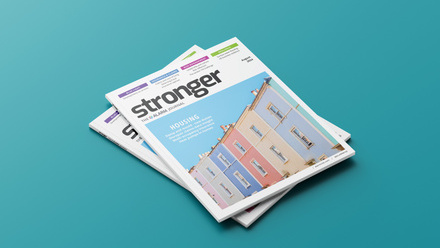Can the negative consequences of this cycle be mitigated by proactive approaches to debt? What does the data predict for 2022 trends?
Economic data from 2021, continuing into 2022, reflects that of increasing vulnerability for already financially vulnerable businesses and households.
The Registry Trust predicts the trajectory of indebtedness to be akin to that of the post-2008 financial crash; a steady incline leading to a peak as financially protective measures continue to be removed. So far, that prediction has run true.
The Registry Trust report What does 2022 hold for financially vulnerable households in the UK? highlights the lack of progress that has been made in promoting financial inclusion and building financial resilience since the 2008 financial crash. The live nature of Registry Trust data allows monitoring of indebtedness and financial vulnerability daily, for both consumers and commercially.
‘The position of financially vulnerable households in 2022 looks bad,’ according to What does 2022 hold for financially vulnerable households in the UK?, which identifies three interconnected, strategic goals for government, policymakers, regulators, the financial sector, and civil society organisations to address collaboratively:
- Deal with the existing financial crisis facing households and protect them from further financial harm
- Help affected households repair their finances
- Promote financial resilience against future financial shocks.
According to Citizens Advice almost one in three households lost income as a result of COVID-19, resulting in a larger proportion of people struggling to pay bills; forcing them into a state of debt.
In October 2021 the Office for National Statistics (ONS) reported the number of businesses removed from the Inter-Departmental Business Register (an all-inclusive list of UK businesses) was 50% higher in Q3 2021 than Q3 2020. Also, the number of businesses added (business creations) was just four per cent higher between the two time-frames. This reflects a significant increase in business closures, and subsequent heightened risk of financial vulnerability and indebtedness.
Council tax
Council tax is the most common arrears, with an estimated 3.5 million people believed to be behind on payments. Money Advice Trust estimate £4.4 billion is owed in council tax arrears in England, while the BBC reported in July 2021 that council tax arrears will leave the UK with £3 billion of debt by 2023/24, putting more local councils at risk of bankruptcy.
Old-fashioned council tax collection techniques and severe responses to failure to pay, make it difficult for individuals to get back on track once payments are missed. 2021 judgment data highlighted a stark increase in CCJs against consumers in England and Wales.
Proactive approaches to improving the system of council tax collection must be introduced, including:
- Removal of out-of-date methods of collection (the mail and telephone) in place of digital communications (text or email). This would also cut increasing postage costs, particularly when posting many follow-up or reminder letters.
- Affordable payment plans rather than one lump sum.
- Move the rate of council tax payments from government level to local level with the aim of reducing the rate of council tax to a more affordable level. Despite lower costs, this method might generate more income through a higher response rate.
- Higher council tax for higher valued properties. Currently, the wealthy pay much less proportionally.
County court judgments (CCJS)
Tackling the root cause of arrears is vital to truly be proactive.
Recommendations include:
- Improving financial fitness. This could include increasing education on repaying debts as soon as possible, checking lenders’ interest rates, checking and maintaining a good credit score, and seeking free debt advice.
- Further investigation into the link between CCJs and insolvency. A recent Registry Trust study exposed a clear link between CCJs and insolvency, with 22% of businesses in the cohort becoming insolvent after just one CCJ, and 78% of businesses becoming insolvent withing 999 days of their first CCJ.
- Improve the satisfaction rate of CCJs. The number of monetary judgments marked as satisfied (or paid) on the register was two per cent lower in 2021 than in 2020. This reflects either fewer people repaying their debts, or fewer people notifying the courts of their repaid debts, both of which are detrimental to finances.
- Improving the current lack of financial safety net.
- Improving debt advice. A study conducted by Registry Trust highlighted that as face-to-face debt advice as a percentage of demand increases, CCJs decrease across regions of the UK. This means areas with higher rates of CCJs are subject to the least debt advice. If free face-to-face debt advice is not feasible, investment should be made in greater coverage and awareness of over-the-phone services.
The rise in CCJs against consumers in England and Wales from 2020 to 2021 heightens the probability of business closures and job losses in the coming year. These continuing job losses and closures are likely to have further detrimental effects on local governments and public service organisations through reduced quality of services such as libraries, parks, and sports facilities.






